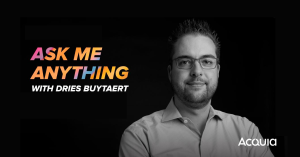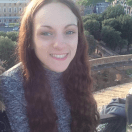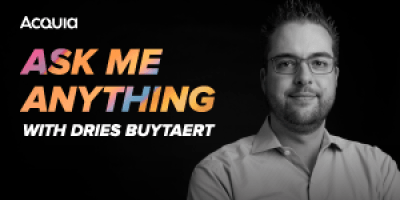
The World-Changing Potential of Open Source: Q&A with Dries Buytaert

“How hard will it be to upgrade to Drupal 9?” “What's the future of Mautic look like with Acquia?” “What can we do to make Drupal more user-friendly?”
As the Drupal community expands and open source software becomes a larger influence in mainstream business, new questions pop up every day about what’s around the corner. As a member of the Acquia team, I’m always learning about new initiatives and developments happening across the larger Drupal community, but it can be hard to know where to search for a straight answer. Luckily, Drupal’s founder and Acquia CTO, Dries Buytaert, recently hosted an “Ask Me Anything” live Q&A to address what’s next for Drupal and share his hopes for the future of open source.
The Q&A was a great chance to hear what open source developments and customer experience trends people are most interested in, as well as get a firsthand account of just how much Drupal has evolved since its start as a basic web framework. Questions ranged from the scalability and sustainability of open source to how to prepare for the release of Drupal 9 to the correct pronunciation of Buytaert (hint: “Buy-Art”). Hundreds of members of the Drupal community tuned in and participated in the webinar, submitting their questions via Twitter as well as in the live webchat.
Dries heard your questions and here are a few of the top highlights from the webinar on the potential of open source and the evolution of the total digital experience. For the full hour-long conversation, you can always check out our recording as well. Let’s dive in!
What were the main challenges with open source development you had to overcome?
Dries: It all comes down to scaling the project. For example, in 2005, Drupal.org was running on a shared server. There was so much traffic coming to our website that the server literally melted. The challenge was that we needed $3,000 to buy a new server. Well, I didn’t have $3,000, but still needed to find a way to scale our infrastructure.
So, how did you solve it?
Dries: It’s a funny story. I replaced every page on our website with an empty page with a PayPal button that said “Please give us money to buy a new server,” and in just 24 hours we had raised around $10,000! People were so willing to get involved, and I still believe so much in the importance of contributors to keep open source and Drupal sustainable and growing.
Moving forward, our focus is to not only sustain open source projects but to enable them to scale. The biggest problem in growing open source today is enabling enough contributors who give back to the project and make it sustainable and scalable.
As we move toward the release of Drupal 8.8, what are the things that you would argue make Drupal a better platform than WordPress?
Dries: First of all, I think it already is a better platform. But there are ways we can still improve. It comes down to the learnability and usability. The learning curve for Drupal is currently steeper than WordPress, but we’re investing in the platform to make it better to use. We’re investing in easier demos, Layout Builder and making it easier to manage media across the platform.
We are also working to implement more no-code, low-code features. Organizations care about speed, usability and total cost of ownership. They want to be able to drag and drop and create sites quickly.
What are the future plans for Layout Builder given the acquisition of Cohesion (now, Acquia Site Studio)?
Dries: We're working on making Layout Builder full-page, and we're investing in making it easier to use. Site Studio’s layout builder, Layout Canvas, currently has more features than Layout Builder, so we want to implement some of those valuable features into Layout Builder to make it even better.
As the release of Drupal 9 approaches, what should we expect when dealing with the switch from D8 to D9?
Dries: The goal is to make it as easy as possible. As we change things in Drupal, we are making sure there’s backward-compatibility and we aren’t breaking existing modules. When Drupal 9 is released next summer, the key is to make sure that you’re not using deprecated APIs. To help with this, we’ve provided a lot of automation and detailed documentation. If you’ve upgraded your modules to use non-deprecated APIs, then the upgrade should be seamless.
What’s the roadmap look like for Acquia Campaign Studio and its connection with Drupal?
Dries: Campaign Studio and Drupal already work together, and we’re working to improve that integration. We’ve already significantly increased the Campaign Studio engineering team to accelerate the platform and started working toward implementing Mautic within Acquia’s own internal marketing team. We’re implementing more integrations in Campaign Studio that weren’t previously available and making all of those integrations available to the open source community.
How’s Acquia poised to outperform competitors?
Dries: Our strategy is to do more than just websites. We’re building a great digital experience platform. We think about our customers’ problems holistically. We think about how they can do more with less in order to become a great digital business. It’s not about just keeping a site running; it’s about the entire digital world. Unlike competitors who think primarily about having a website, we’re building a whole platform that looks at how to make the entire customer experience better. By investing in marketing technology like Campaign Studio, Site Studio and personalization tools, we’re offering a complete solution.
Any preview about what to expect for either your upcoming DriesNote at DrupalCon or Acquia’s Engage New Orleans conference?
Dries: The Driesnote at DrupalCon Amsterdam will focus a lot on Drupal 9 and the progress we’re making in helping companies prepare for the update, as well as a big focus on sustainability.
With Engage, one thing we’ll be previewing is how we’re investing in and using containerization. We’ve been doing a lot toward becoming more efficient, helping our customers’ websites become faster and making their infrastructure even more reliable and secure.
What technology do you wish you could have created yourself?
Dries: I’m intrigued by the whole blockchain thing. There are so many negative things about blockchain right now in terms of power consumption. But I’m an optimist about its potential in the same way that I believe we can create more sustainable open source projects. The root problem for technology like this is multi-coordination. It’s getting people to collaborate and getting the funds to build and scale projects.
There are a lot of problems today that are multi-stakeholder problems, and these can’t be fixed unless we all purposely work together. Technologies like open source and blockchain have this exciting future potential to empower people to work as a team and fix really big problems in the world. This solution hasn’t been invented yet, but I hope to see it get there one day.
---------
When the Q&A wrapped, I left feeling as optimistic and eager as Dries about the future of open source and our power as a larger community to keep working together toward smarter, innovative solutions. From fixing a broken server to working toward the future of a totally open web, every achievement starts by asking a question and coming together to create a solution.
If you’d like to watch the full AMA, you can get the webinar recording here.

